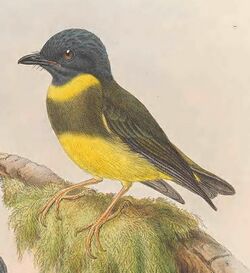Biology:Banded yellow robin
| Banded yellow robin | |
|---|---|

| |
| Illustration by John Gould and W. Hart | |
| Scientific classification | |
| Domain: | Eukaryota |
| Kingdom: | Animalia |
| Phylum: | Chordata |
| Class: | Aves |
| Order: | Passeriformes |
| Family: | Petroicidae |
| Genus: | Gennaeodryas Mathews, 1920 |
| Species: | G. placens
|
| Binomial name | |
| Gennaeodryas placens (Ramsay, E.P., 1879)
| |
| Synonyms | |
|
Poecilodryas placens | |
The banded yellow robin or olive-yellow robin (Gennaeodryas placens) is a species of bird in the Australasian robin family Petroicidae that is found in New Guinea. It is the only species in the genus Gennaeodryas. Its natural habitats are subtropical or tropical moist lowland forest and subtropical or tropical moist montane forest. It is threatened by habitat loss. It has a high mortality rate due to its inability to traverse across a matrix.[1]
Taxonomy
The banded yellow robin was described by the Australian zoologist Edward Pierson Ramsay in 1879 from a specimen collected in southeastern New Guinea. He coined the binomial name Eopsaltria placens.[2] The species was subsequently placed in the genus Poecilodryas.[3] It was moved to the resurrected genus Gennaeodryas based on the results of a molecular phylogenetic study published in 2011.[4][5] The genus Gennaeodryas had been introduced by the Australian ornithologist Gregory Mathews in 1920.[6] The genus name combines the Ancient Greek gennaios "noble" or "high-born" with dryad "tree-nymph".[7] The specific epithet placens is the Latin word for "charming" or "pleasing".[8]
References
- ↑ "Scopus preview - Scopus - Welcome to Scopus" (in en-US). https://www.scopus.com/record/display.uri?eid=2-s2.0-84872453741&origin=resultslist&sort=plf-f&src=s&st1=banded+yellow+robins&st2=&sid=e4c648ab7582cd83a2cea40f4ace6076&sot=b&sdt=b&sl=35&s=TITLE-ABS-KEY(banded+yellow+robins)&relpos=0&citeCnt=5&searchTerm=.
- ↑ Ramsay, E.P. (1879). "Contributions to the zoology of New Guinea. Parts I and II". Proceedings of the Linnean Society of New South Wales 3: 241-305 [272]. doi:10.5962/bhl.part.22241. https://biodiversitylibrary.org/page/6456651.
- ↑ Mayr, Ernst; Cottrell, G. William, eds (1986). Check-list of Birds of the World. Volume 11. Cambridge, Massachusetts: Museum of Comparative Zoology. p. 576. https://biodiversitylibrary.org/page/14484277.
- ↑ Christidis, L.; Irestedt, M.; Rowe, D.; Boles, W.E.; Norman, J.A. (2011). "Mitochondrial and nuclear DNA phylogenies reveal a complex evolutionary history in the Australasian robins (Passeriformes: Petroicidae)". Molecular Phylogenetics and Evolution 61 (3): 726–738. doi:10.1016/j.ympev.2011.08.014. PMID 21867765.
- ↑ Gill, Frank; Donsker, David, eds (2019). "Australasian robins, rockfowl, rockjumpers, Rail-babbler". World Bird List Version 9.2. International Ornithologists' Union. https://www.worldbirdnames.org/bow/au_robins/. Retrieved 17 June 2019.
- ↑ Mathews, Gregory (1920). Birds of Australia. Volume 8. London: Witherby. p. 186. https://biodiversitylibrary.org/page/53480695.
- ↑ Jobling, J.A. (2019). "Gennaeodryas". in del Hoyo, J.; Elliott, A.; Sargatal, J. et al.. Handbook of the Birds of the World Alive: Key to Scientific Names in Ornithology. Lynx Edicions. https://www.hbw.com/dictionary/definition/gennaeodryas. Retrieved 17 June 2019.
- ↑ Jobling, J.A. (2019). "placens-placentis". in del Hoyo, J.; Elliott, A.; Sargatal, J. et al.. Handbook of the Birds of the World Alive: Key to Scientific Names in Ornithology. Lynx Edicions. https://www.hbw.com/dictionary/definition/placens-placentis. Retrieved 17 June 2019.
- del Hoyo, J.; Elliot, A. & Christie D. (editors). (2007). Handbook of the Birds of the World. Volume 12: Picathartes to Tits and Chickadees. Lynx Edicions. ISBN:978-84-96553-42-2
Wikidata ☰ Q1590184 entry


